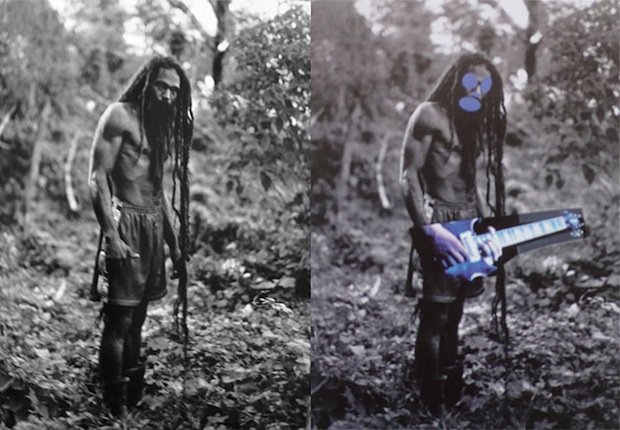
Image from Patrick Cariou's book "Yes Rasta" (2000) p 118 | Richard Prince's "Graduation" (2008) (Image courtesy of Hyperallergic's tumblr)
Postmodernism is having the best day ever. It’s been just over a year since a New York District court dealt a major blow to Richard Prince, finding his Canal Zone series guilty of violating the copyright in Panamanian landscape photographs and Rastafarian portraits by Patrick Cariou. Not only was Prince found guilty, but the court ordered all unsold Canal Zone artworks and catalogs sent to Cariou so that they could be destroyed, sold, or disposed of as he saw fit. Thankfully, today sees a win for art: the case’s defendants won an appeal with the United States Court of Appeals for the Second Circuit.
Gagosian and Prince appealed that decision on the grounds that Prince makes fair use of Cariou’s photographs, often altering them very slightly with painting and collage. The Supreme Court only defines fair use as needing to “alter the original with ‘new expression, meaning, or message.’” The lower courts interpreted this to mean that, in order to make fair use of Cariou’s photographs, Prince must “comment on Cariou, on Cariou’s Photos, or on aspects of popular culture closely associated with Cariou or the Photos.” (Satire, for example, would be fair, as in the ruling’s mention of 2 Live Crew’s parody of Roy Orbison’s “Oh, Pretty Woman”). The higher courts disputed that definition: “We agree with Appellants that the law does not require that a secondary use comment on the original artist or work, or popular culture…” In other words, the appellate court has allowed Prince to use the images for personal expression.
This was, and still is, a big deal: if the first ruling were applied across the board, anyone who’s ever copied, altered, collaged, or generally riffed on virtually anything could be in huge legal trouble. For the lower court, Prince didn’t transform Cariou’s originals enough; the alterations (like pasting Baldessari-esque dots to faces or collaging nude bathers in a manner akin to Picasso’s Demoiselles d’Avignon) were minimal. The ruling is full of considerations as to what this would mean if artists were no longer allowed to reinterpret other people’s images. Just for an idea of what that would look like, the court mentions that even Andy Warhol potentially wouldn’t have been safe from the ruling:
Much of Andy Warhol’s work, including work incorporating appropriated images of Campbell’s soup cans or of Marilyn Monroe, comments on consumer culture and explores the relationship between celebrity culture and advertising.
Still, the appeal leaves it to the lower court to decide just how much an artist needs to affect an image in order to change it. There are still five photographs the court has refused to judge (Graduation, Meditation, Canal Zone (2007), Canal Zone (2008), and Charlie Company)–because their alterations are so small. They write of those images:
While the lozenges [in Graduation], repetition of the images, and addition of the nude female unarguably change the tenor of the piece, it is unclear whether these alterations amount to a sufficient transformation of the original work of art such that the new work is transformative.
And, when it comes down to it, that’s a question of whether, and for whom, these are effective works of art.


Comments on this entry are closed.